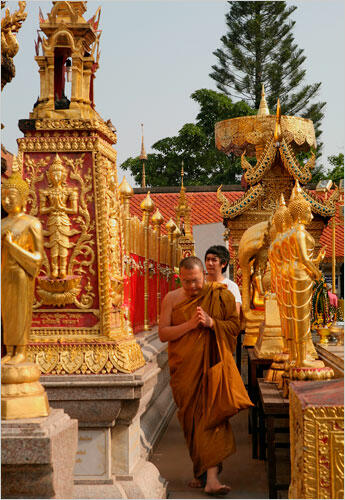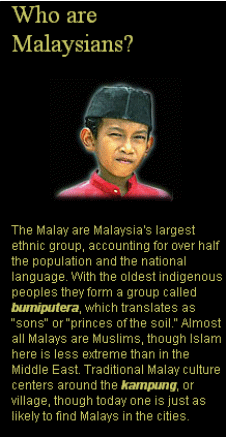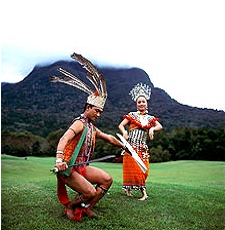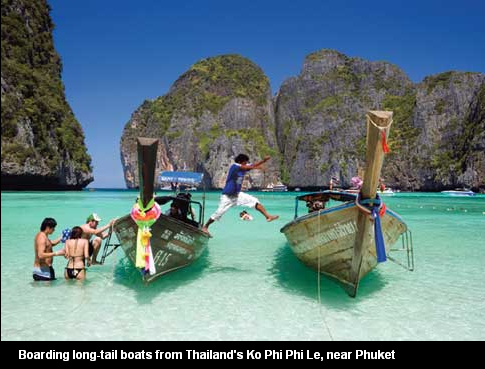Abstract
Tourism the abstract thing now a day is the best service to earn a lot of tourism currency. The importance of this sector is growing rapidly due to geographical, political traditional, social and economic concerns. Now, tourism is going to be for the Asian countries for the rent few years. Malaysia, Thailand, India, Nepal, Indonesia, Singapore are the most closable destination for the tourist. While the tourist comes to a country for their recreation or for there the tourists come to close with the local people and culture. There they share their culture, views, news and even their values which do effects on both the tourists and local’s culture. This effect can either be positive or negative. If we think it from the positive point of view, then we can see that when tourists visit to a country there they spend a handsome amount of money which ultimate contribute to the GDP of that country and an amount of it goes to the hand of the local people.
When the people have handsome income then their live standard comes up and upgrade their values and beliefs, tradition, nationalism and thinking, but one thing can’t be left unmentioned here that is in some cases tourism turn the local culture as commodities. Here, our discussion will be on the cultural changes of Thailand and Malaysia through tourism. Thailand is one of the leading tourism destination of tourism sector to total export was 14% in 1995. For the last few years it has been rising dramatically. Now Thailand is drawing the attractions of tourists with the slogan, “The land of smiles”. This tourism sectors has created a lot of employment opportunity for the local people. From this they are generating income and increasing this living their values and developing this culture. The same thing is for the Malaysia. Malaysia with its multiculturalism is home to delightful festivals, celebrations and feasts all round the year. The Malaysia celebrates their cultural festivals nationwide as well as state-wide.
The Analyzing Factor as ‘Religion’, which Mobilizes the Culture
In the age of market economy, every capitalist country deserves the free entrance to another country’s economy and interact some common culture between them. However, tourism is potential part of economy. Before proceeding to the main point it will be better to define tourism and culture. Tourism is an economic component of a country that may be influenced by the components of culture such as nationalism, traditions and beliefs, popular culture, ethnicity gender or religion indigenous culture etc. However, here ‘Religion’ is a most important factor to discuss that effects Tourism most. According to Esposito and Voll (1996), in the present age, the Muslim groups involve themselves into the domestic process. Muslims believe that their democracy is standing belongs with their religion, though their government or political system, ultimately, influenced with a global change.
Culture, Religion & Tourism and their Relationship
The word culture comes from the Latin word ‘Cultura’, which is related to cult or worship. In broadest sense, this term refers to the result of human interaction. So, “culture is the acquired knowledge that people use to interpret experience and generate social behaviour. This knowledge forms values and creates attitude and influences behaviour.
There are some distinguishing nature of culture, those are:
- Learned: Culture is not inherited of biologically based, it is acquired by learning and experience.”
- Shared: People as members of a group, organization or society share culture; it is not specific to single individuals.
- Trans-generational: Culture is cumulative; it passed down from one generation to the next.
- Symbolic: Culture is based on the human capacity to symbolize or use one thing to represent another.
- Patterned: Culture has structure and it is integrated, a change in one part will bring change in another.”
- Adaptive: Culture is based on the human capacity to adopt or change.
Tourism is a significant economic sector of a country. Tourism is like as via of decentralizing the culture and sharing the amusement of fascinating things or festive. However, through tourism culture is diversified one country to another. It creates a global culture across the countries and makes the culture with mixing up to another via tourists.
Tourism of a country, depending on some conditions, attracts or motivates the people to a country’s culture and tradition. The conditions are as the attractions of traditional beliefs, variation of tribes, geographical fascination, structural beautification, religious value, festivals and cultural functions, natural heritage, and other facilities for tourism. All of these things are related to one’s most important things like economy, culture and society. Ultimately, tourism is directly or indirectly related to the economy, culture and society.
Culture is the superior determiner to analyze a country’s whole socio-economic characteristics. The performance and output of tourism depend on the cultural strength of one. Religion is the part and parcel of culture, which ultimately affects the culture. Culture cum Religion is the thing which mobilizes every sector of a society and economy cum tourism. Culture is the superior determiner to analyze a country’s whole socio-economic characteristics.
Constructions of Culture and Promotion of Tourism (Malaysia vs. Thailand)
Tourism of Thailand: In perspective of culture
Kingdom of Thailand is a South- Asian country. Bangkok is the capital city. Thailand’s total area is 514000 square kilometers. It has a population of 61797751 (July 2001). Among this population Thai ethic that’s ethnic origin lies in India, China or elsewhere with ethnic distribution as- Thai (80%), Chinese (10%), Malay (3%), and the rest are minorities (Mons, Khmers, hill tribes). And by 2050 its estimated population is 70295643. Thai and English languages are mostly used here. Literacy rate is 93.8% (1995). Buddhism is the predominant religion here. 95% of the total populations are Buddhist (‘Theravada Buddhism’) (1991). Beside them 3.8% Muslim and 0.5% Christianity people live here. The government type of the kingdom of Thailand is constitutional monarchy. Tourism, textiles, garments, tobacco, cement, etc. are the main industries. Main agricultural sectors are rice, cassava, rubber etc. Tin, rubber, natural gas, tungsten etc. are common natural resources (Tourismthail).

Thailand is populated with fun-loving, smile-faced, happy-go-lucky people. People are proud for their fighting spirit. Thailand was known as Siam formerly. The important fact is that Thailand has never been colonized by any foreign power. It is the result of their struggles for centuries to hold their independence. This country has been influenced by different foreign cultures through their tourism specially. But still Thai culture has unique stuffs. According to Kislenko (2004) states that the development of culture remains in various sectors of society such as “Literature, Theatre, Dance, Music, and Film, Art, Architecture and Design, Cuisine and Traditional Dress, Gender, Courtship, and Marriage, Festivals and Fun, etc.”
Esterik (2002) concentrates on how the Thai state has fashioned a modern Thai identity and in the process created certain images of the Thai women. Esterik’s discussion of these events shows how women and heritage site have both become commoditized and available to tourists as icons of Thailand. Esterik argues that the Thai concerned with beauty and appearance is “a bridge linking national identity and public culture to prostitution and sex tourism” (Esterik, 2002, p.131). Esterik’s research found that “provincial governors are encouraged by the Tourist Association of Thailand (TAT) to hold beauty contest to promote tourism and sales of local products” “Further local contests facilitate recruiting the most beautiful girls into prostitution” (Esterik, 2002, p.153).
It is said that commoditized sex is not new in Thailand. Daughters repay debts to their parents by getting married wealthy men who can supply bride wealth, or by becoming a prostitute and sending remittances home. Either case sexual relations are not without cost.
Tourism of Malaysia: In Perspective of Culture

Malaysia is located in the south of Thailand in south-east Asia. Geographically it has an area of 329,758 square kilometres (127,320 square miles). The size of population is likely as 21,793,000 in July 2000 and current population growth rate is 2.01%. Malaysian economy mostly depends upon manufacturing, agriculture, technological acknowledgement, tourism, natural resources such as tin, oil and gas, etc. (Malaysia – Country overview). Malaysia is almost an attractive tourist country in the world. To the Malays (native born Malays, known as Bumiputras) and the people from abroad, it’s almost fascinating.
With the view to geographical aspects, religion, indigenous culture and costume, traditional belief and community, Malaysia is enlightened by itself along with distinct features. Above upon average, this country deserves the priority to the Tourists choosing a Southeast Asian country. Though Most of the Malays are Muslim, the govt. of Malaysia announces it as a moderate Muslim state. Hourdequin (23 November 2007) explains overwhelmingly the influence of Islamicist threat in case of tourism. Hourdequin (23 November 2007) states that-
“To deal with the Islamicist threat, Abdullah Badawi – Mahathir’s hand selected successor – has continued in a tradition of moderate Islamic leadership consistent with the concept of Islam Hadhari, or ‘civilizational Islam’” (Hourdequin, 23 November 2007).
Locally and to the visitors, Malaysia is called as ‘Paradise’. Visitors, at a glance, like this zone as well as like its geography, culture, tradition, belief and nationalism. “Malaysia is paradise. Its sun-drenched eaches, enchanting islands, diverse flora and fauna, forest retreats and magnificent mountains are among the best in this region” (about-malaysia.com. Mar-2006). Malaysia is a wonderland of south-east Asia. It’s the land of multi-dimension and mythic culture. “A multi-ethnic, multi-cultural and multilingual society,” (Bhattacharya, 2005). With the combination of the community of the Malays (58%), Chinese (26%), Indians (7%) and other ethnic groups (9%) make a mix culture over Malaysia. The largest communities, Malays are Muslims. Though they maintain religious beliefs and restrictions of Malaysian law, they maintain respects upon Christian, Buddhist, Hindu and others. “All of Malaysia’s communities open their doors to members of other cultures during a religious festival–to tourists as well as neighbors. Such inclusiveness is more than just a way to break down cultural barriers and foster understanding. It is a positive celebration of a tradition of tolerance that has for millennia formed the basis of Malaysia’s progress” (InterKnowledge Corp., 1996-2006).

This religious belief of Malays makes a respective environment in various religious communities through internal and external of the country. Hourdequin (23 November 2007) said, “Islam has always played a significant role as one of Malaysia’s important core values”.
And this trend enhances the opportunity of tourism. Besides this, another incentive is the tribal groups. There are a number of tribal group (5% of total people) remaining with a distinguishing culture. The ancient native people of Malaysia are known as the tribal group. The majority of the tribes live in the Sarawak and Sabah. Major tribe group of Sarawak is ‘Dayak’ who still live in traditional ‘longhouses’. Another tribe is Orang Asli, lives in peninsular Malaysia.
People of this country have been surviving in the existence of their culture and costume for a long period of time and they are continuing their successes. With preserving a balance with nature, this country is possessed as a coloured and beautiful one with the touches of Malays and tourists. Many functions and festivals colour this ‘Paradise’ respectively whole over the year. That’s, however, attracts tourists form every corner of the world. “A huge 20.7 Million foreign tourists came to Malaysia in 2007 and crossed 20.1 Million mark set as the goal for the Visit Malaysia 2007 campaign. Maximum tourists visited the country came from ASEAN countries followed by Japan, China and Australia. Now experts are targeting new markets, which include India and the Middle East” (RNCOS Retail Sector Research. January 14, 2008). Some reputed Tourist zones of Malaysia are as follows- Kuala Lumpur – A Passage Back in Time, Penang – Pearl of the Orient, Kuantan; Malacca – Historical City, Sarawak Cultural Village, The eye of Malaysia etc.
Constructional Comparison of the two country’s Religious Culture
Since the 10th century to 1930s Malaysia was in colonial curse. Its political sovereignty was to the British and economic sovereignty to the Chinese. “Malaysia reformed as an independent country in 1957, after the Sino Japanese war in 1930’s” (About Malaysia and Bhattacharya, 2005). But Thailand, from the beginning, was never been a colony of other. So with the viewing historically, Malays influenced vastly politically and economically by others which was a fact for influencing their culture. Politically, Malays’ economy is controlled much by the construction of its govt. religious policy. According to Hourdequin (23 November 2007), “Malaysia needs trade from all quarters, not just the Muslim world, and thus Mahathir and then Abdullah Badawi have sought to maintain a moderate Muslim state in the heart of Southeast Asia that still holds on to a core Islamic identity.”
Besides, the Thai have developed their politics and economy with their own way accompanying with their own culture. Malaysia has been developing rapidly since 1971. So culturally, the Thais are enriched more because of their long independency in their policy and economy. Being influenced through the religious culture, there are some expected views of estimations of the contribution of travel and tourism on Malaysian and Thai economy extracted by WTTC (World Travel and Tourism Council) for the year, 2008, as their previous performance are as follows–
In the sense of tradition, it’s more distinct than Malaysia. Structurally, there are some symbols of development of Malaysia and Thailand. There are various city excitements such as buildings, parks, city streets, transports, etc. In Malaysia, large numbers of high raised buildings are the attractions of Malaysia. Such as ‘Petronas Twin Towers’, one of the largest towers in the world located in the heart of the capital city ‘Kuala Lumpur’. On the other hand in Thailand, large number temples are seen over every city. As a Buddhist country temple is possessed as a part of its culture. Thereby, temple can be called the icon of Thailand. Mulder (2000). in his book ‘Inside Thai Society’, said about the beauties of Thailand as “Thailand is often called ‘The Land of Smiles’, a sobriquet which sounds at once pleasant and mysterious.”

Besides, there are lots of natural views across both of the two countries, known as the tourists’ sights, are mind-blowing amusing, admiring, fascinating, heavenly to the people. There are many beautiful islands, hills, beaches lakes etc. over Malaysia and Thailand.
Religion is an important factor for influencing the culture. Malays and Thai people both are respectful to their religion. As a Muslim dominated country, Malays are very careful to their religion, although they make their country free for the tourists. They maintain their religious constitutions at all. This belief makes a religious culture in side the country and also makes a fair and peaceful country for tourism. Besides, Thai’s are also respectful to their religion. But here religious beliefs are not so limited but liberal than Malays. It deserves a liberal religious cultural environment through its name ‘Kingdom of Thailand’. “The King in Thailand was believed to be participating in divinity; hence the need for images in state ceremonies and Brahminical rites. Idealized religious images in royal regalia were made to remind worshippers of the late monarchs, and the images became sanctified in response to the belief that the spirits remained in them” (Flores, n.d. p.5).
Therefore, tourists enter here more freely. Through there remains secular religious culture, Thailand is influenced by foreign culture mostly. As Malays are influenced by the religion and they have the respects about their religious culture as well as the religious values, beliefs, they are more collective than Thai people in their family strength and status where Thai people believe in free culture and they are not strength in collectivism. The Thai people, however, because of their high ambition of being rich and multi-national culture, they scattered into individualism. In this circumstance, those of two perspectives are effective to attract the tourists differently.
Another constructional component of culture is the tribal group. Tribes colour the culture and attract the people to be coloured. These promote the culture to enlightening tourism. However, tribes exists their ethnic features through both countries. Specially, in Malaysia, ethnic group are more powerful than Thailand. Bumiputras are Muslim dominated native born people.
Though prostitution is, however, a negative approach of promoting the culture, even than it stands as a significant position with regards to promoting the tourism world. This draws attentions of many international tourists easily. Culturally, as the Thai people are more liberal, however, they are habituated largely to this. It’s a common belief of the Thai women that they can bear their parents through this profession and can easily be rich. But Malays, as Muslims, are not much habituated to like secular culture like Thai people.
Considering those motivations, the governments of both of the two countries are aware about the development of tourism, tourists’ satisfaction and the policies that effect tourism. “In the final decades of the twentieth century, an important type of Muslim leader/intellectual became prominent, playing a significant role in Muslim reconceptualisations of religion and international relations” (Esposito, December 2000).
Esposito (December 2000) also exampled as a prominent leader of Malaysia as Muhammad Mahathir Muhammad. Economic growth of Malaysia and Thailand is increasing continuously. Tourism deserves a great contribution on economic growth. Now a days, Thailand and Malaysia play potential part in the influencing the Tourism sector of Asia. Malaysia plays their religious factors fairly. There has less Islamic outer problem from abroad in Malaysia rather than other Islamic country like Pakistan, Afghanistan, Iran, Iraq, etc. “Malaysia has been free from the radical politics and confrontation that government repression has produced in other parts of the Muslim world” (Esposito, and Voll, 1996, p.148)
Culturally those two countries are developed with its own traditions, beliefs, values, ethics, etc. As we know, culture directly or indirectly influence the prominent factors of a country such as economy, society, individual factor, politics, etc. and ultimately Tourism. Hence, Religion, Culture and Economy those are vital factors for Malaysia and Thailand, and inter-related with one another.
Conclusion
As Thailand is the icon of south-east Asian tourist zone, Malaysia plays also as a roll model country in this zone. We have already seen that the backbone of this legendary valuation of tourism is culture. Both of the countries are enriched culturally. With distinction of multi-cultural, multi-ethnic and multi-lingual view, these two country’s religions are different as well as cultures are mostly different. The clusters of culture of both countries impact differently on their local and international tourism. In spite of different religious beliefs and values through the two countries, the common constructions of culture are maintained across there to increasing the attractions of tourism locally or internationally.
For example, Travel facilities (accommodations, traditional and international hotels and restaurants, foods and drinks, etc.), Cultural function, Tribal variation, Govt. policy, Nationalism, Cultural motivation, Better public relation, Tourist satisfaction, individual’s attitude and ethics, Native’s hospitality, etc. are maintained with a symphony in both countries. Those factors are related somehow religion. In thus way, people, being influenced by religion, promote there culture as well as they promote their tourism industry. Really Thailand deserves the title ‘Kingdom of Thailand’ and Malaysia truly is possessed in the slogan ‘Malaysia Truly Asia’. However, though south-east Asia holds less than of 11% of world tourism, it’s increasing its percentage day to day, Thailand is now the most leading country and Malaysia, as well as Singapore, Indonesia, is an up-coming leading country in tourism in south-east Asia. So, it can be said that these countries will probably be the kingdom of tourism world very soon to the Asians and the others.
References
About Malaysia – Malaysia An Oriental Tourist’s Haven and an Anthropologer’s Delight! – Travel Information. Web.
about-malaysia.com. (2006). About Malaysia – Malaysia Travel Information Guide. Web.
Bhattacharya, Lopa. (2005). Malaysia: An Oriental Tourist’s Haven and an Anthropologer’s Delight!. MyMalaysia.com. Web.
Esposito, J. L. (2000). Islam and the West: Muslim Voices of Dialogue, pp. 613-639(27), Vol. 29, No. 3, 1. Millennium Publishing Group.
Esposito, L. John., and Voll, O. John (1996). Islam and Democracy: Islam Democracy. Oxford University Press:USA.
Esterik, Van Penny. (2002). Materializing Thailand. The Journal of Asian Studies. Vol. 61. No. 2. pp-794-796 Published by: Association for Asian Studies. Web.
Flores, D. Patrick (n.d.). Colonial Posterities: Portraiture and the Face of the Modern. Web.
Hourdequin, Peter. (23 November 2007). International Relations of the Asia-Pacific Advance Access. Malaysia’s 2005–2006 Refugee stand-off with Thailand: a security culture analysis. 1-16. International Relations of the Asia-Pacific. Oxford University Press. Web.
InterKnowledge Corp. (1996-2006). Kaleideculture. Web.
Kislenko, Arne (2004). Culture and Customs of Thailand. Greenwood Publishing Group, Inc.
Malaysia – Country overview, Location and size, Population, Industry, Mining, Manufacturing, Services, Tourism.htm.
Mulder, Niels. (2000). Inside Thai Society. Silkworm Books. Chiang Mai. Web.
National Geographic. Web.
RNCOS Retail Sector Research. (2008). Tourism – Backbone of the Malaysian Economy. RNCOS.
Thailand- land of smiles. (2006). Information about Thailand Thailand and Thai People. Horizon Thai Boxing Camp Ltd. Web.
The New York Times, Web.
Tourismthail. Web.